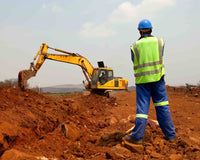When it comes to workplace safety, it's essential to take all the precautions necessary to prevent injuries. One key piece of safety gear is a safety vest.
But how do you select the right one for your needs? And once you've got it, how do you wear it properly? This post will answer those questions and more. Let's discuss it in detail.
How To Choose A Safety Vest?
When choosing a safety vest, there are several factors you need to take into account to ensure that you're getting the best possible product for your needs. These include the material the vest is made from, the amount of reflective required, the type of closure, and the number of pockets.Material
The material of the safety vest is crucial because it will determine how visible you are. If you need to be highly visible, a mesh vest is a good option. However, if you don't need to be visible, then a solid vest will do just fine.Types Of Closure
The type of closure is also essential. Velcro is a good option if you need to be able to put the vest on quickly. However, if you need a more secure closure, a button or zipper is better.Choosing by ANSI Type
Consider ANSI classes when looking for high-visibility safety vests. They include:ANSI/ISEA 107-2015
American National Standard for High-Visibility Safety Apparel and Accessories – ANSI/ISEA 107-2015 establishes performance requirements, test methods, and labeling requirements for high-visibility and reflective safety apparel and accessories used in occupational settings under conditions where workers are exposed to low-visibility conditions. There are three class levels of garments defined within ANSI/ISEA 107-2015. The level of the garment is based on the amount of background material and retroreflective material.Non-ANSI Safety Vests
Non-ANSI compliant vests do not adhere to specific size, shape, or reflectivity standards. These vests can be made from various materials, including polyester, cotton, or nylon. While they may have some reflective tape, they will not have enough to comply with ANSI standards. Non-ANSI safety vests are not recommended for use in any work environment.Class 2 Safety Vests
Class 2 safety vests are required when workers are exposed to medium-speed traffic. These vests must have 775 square inches of background material and 201 square inches of retroreflective material. The background material must be fluorescent yellow-green, fluorescent orange-red, or white. The reflective vests' material must be white, yellow, or red.
Class 3 Safety Vests
Class 3 safety vests are required when workers are exposed to high-speed traffic traveling over 50 mph. These vests must have 1,240 square inches of background material and 310 square inches of retroreflective material.Public Safety Vests
Public safety vests are required when workers are exposed to traffic traveling over 50 mph and the worker is performing a task involving both hands. These vests must have 1,240 square inches of background material and 310 square inches of retroreflective material.Type O (“Off-Road”) – Occupational HVSA for Non-Roadway Use
Type O occupational high-visibility clothing is intended to provide the wearer with enhanced visibility in all lighting conditions when viewed by a person operating a motor vehicle on a roadway. This type of apparel is not intended to provide the wearer with visibility when viewed by someone using off-road vehicles such as agricultural equipment, construction equipment, or other industrial vehicles.Performance Class 1 (Type O)
Performance Class 1 (Type O) is the minimum level of protection required when working in environments where struck-by hazards are not approaching at roadway speeds. This class provides adequate high-visibility material to differentiate the wearer from non-complex work environments. In these scenarios, operative detection and identification distances can be shorter than in other situations without compromising safety.Performance Class 2 (Type R or P)
Performance Class 2 includes more high-visibility vests, making them easier to see at greater distances. They also provide better detection and identification than Performance Class 1 vests.Performance Class 3 (Type R or P)
Class 3 vests are the highest level of protection as they provide the most visibility. These vests must have background and combined-performance materials on both the pant legs and sleeves. This class is ideal for workers exposed to complex backgrounds or who need to be visible from all angles, such as construction workers, utility workers, and flaggers.FR Vests (Flame Resistant) And Self Extinguishing Vests
FR vests are flame resistant and self-extinguishing. They meet ASTM 1506 standards and are ideal for any worker requiring high visibility and protection from flames, sparks, arc flashes, and other possible flammable situations. FR vests are commonly used by utility workers, welders, public safety personnel, oil field workers, first responders, petrochemical refinery workers, and shipyard workers.
Number Of Pockets
Finally, you need to consider the number of pockets. If you need to carry a lot of gear with you, more pockets are better. However, if you don't need to carry much, fewer pockets will do just fine. Keep these factors in mind when choosing a safety vest, and you'll be sure to get the best possible product for your needs.About Wearing Safety Vests
Wearing a safety vest is essential for many occupations. Construction workers, utility workers, and others who work around vehicles or in low-visibility conditions need to be visible to prevent accidents. There are a few different ways to wear a safety vest to be effective.- The most common way to wear a safety vest is by putting it on over the head and securing it at the waist. This method ensures that the vest covers the entire torso and that it will not come off easily. It also allows for easy removal if necessary.
- Another way to wear a safety vest is by putting it on under the arms. This method is often used by law enforcement and security personnel who need to be able to remove their vest if necessary quickly. It also keeps the vest from riding up and exposing the wearer to potential hazards.





